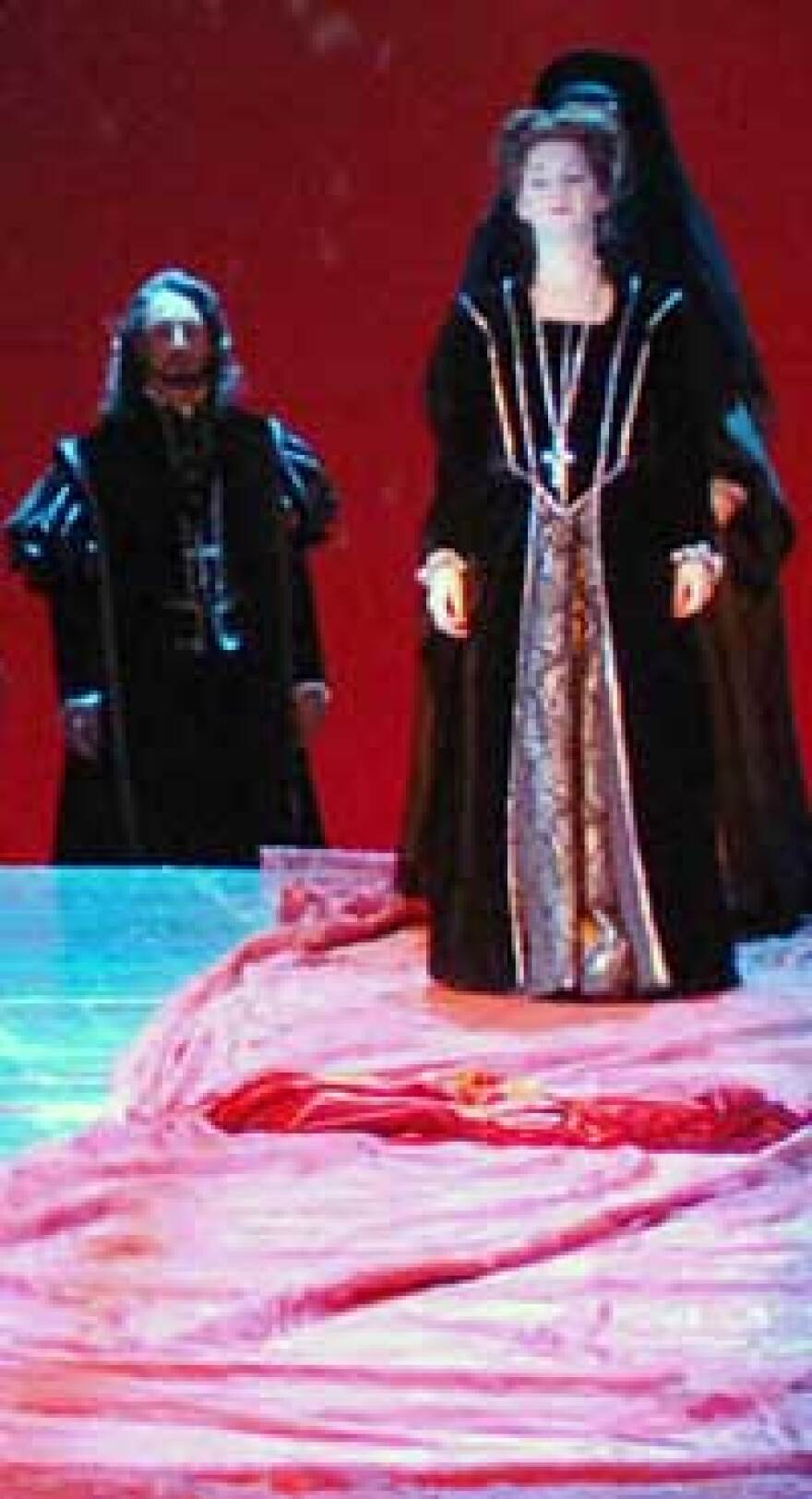
ACT ONE: As the action begins, Queen Elizabeth I is under pressure to marry the Dauphin of France. The marriage would help to solidify the relationship between France and England, and would also counter what the English see as a troublesome alliance between France and Scotland.
But there's a problem. Elizabeth is already in love with Robert, the Earl of Leicester. At court, Robert is approached by Talbot, another English nobleman. Talbot hands Robert a letter from Mary Stuart, who is being held prisoner at Fotheringhay castle. Talbot also tells Robert that Mary spoke of him affectionately — which obviously pleases Robert, who also has feelings for Mary. Through the letter, Mary hopes to arrange a meeting with Elizabeth.
Historically, the conflict between the two women was largely political — Mary had designs on the English throne, and was accused of plots to assassinate Elizabeth. In opera, passion tends to play better than politics. So when Robert approaches Elizabeth about the proposed meeting, she's clearly jealous. Still, something in Mary's letter moves her — or at least seems to — and she agrees to a meeting. In the duet that ends the first act, Robert has hopes that Elizabeth and Mary will reconcile, while the vindictive Elizabeth is determined to punish Mary for stealing Robert's heart.
ACT TWO: At Fotheringhay, Mary is coming out of the woods with her companion, Anna. They're enjoying a fine, sunny day when some hunters appear and announce that Queen Elizabeth is approaching. Mary's mood quickly changes; she now dreads her possible meeting with Elizabeth.
In the next scene, Mary is alone in the castle when Robert enters. He tells her that Elizabeth is on her way. He also warns her that when they meet Mary must be submissive to the Queen. For her part, Mary now hopes she won't have to see Elizabeth at all, as she fears what the Queen might have in store for her. Robert tries to tell Mary that Elizabeth has become more sympathetic towards her but, even after a lengthy discussion, Mary is unconvinced.
When Elizabeth arrives, Robert is the first to greet her. He urges her to reconcile with Mary — but aside, Elizabeth says she still loathes her.
In the opera's pivotal scene, the two women finally meet. At first, Mary is deferential. Elizabeth responds by describing Mary as "vile and iniquitous." At that, Mary loses her temper. In a daring rant, she calls Elizabeth an "obscene, unworthy whore." And she doesn't stop there, adding that the queen is also a "vile bastard" who defiles the soil of England. The act ends as Mary is dragged away, and everyone seems to agree that she's pretty much sealed her own fate.
ACT THREE: Elizabeth is alone with her advisor, Lord Cecil, who can't believe that Mary is still alive after her treasonous outburst. After a brief consultation, Elizabeth concedes that Cecil has a point. She decides that Mary should die and signs the order for her execution.
Historically, Mary Queen of Scots has been portrayed as a woman who had designs on the English throne, and was beheaded for her trouble. The opera treats her more sympathetically. As the title suggests, she's the heroine: a charming, repentant young woman who's doomed, in large part, by her attraction to Robert, the man Elizabeth loves.
When Robert finds out what Elizabeth has commanded, he makes one last attempt to change her mind. Elizabeth dismissively sends him away, after ordering him to witness Mary's beheading.
The final scenes are devoted to Mary's last hours. She meets with Cecil, who delivers the order for her execution. She also speaks with the sympathetic nobleman Talbot, recalling her past and saying that when the throne of Scotland was taken from her, she came to Elizabeth seeking peace. But she also confesses to earlier crimes, including an association with people who plotted Elizabeth's assassination. Talbot says her truthfulness will win her God's forgiveness, and the opera portrays her as an innocent, facing death.
As Mary is joined by some friends, they hear the first of three cannon shots that will signal her beheading. She meets with Robert one last time — and the second shot is heard. Then, as she says last goodbyes to everyone, the third shot rings out, and the executioner leads Mary to the block.
Copyright 2023 NPR. To see more, visit https://www.npr.org. 9(MDM3NjYwMjA5MDE1MjA1MzQ1NDk1N2ZmZQ004))

